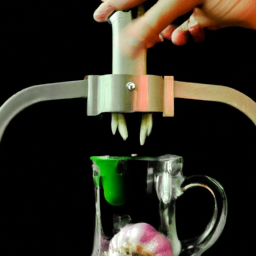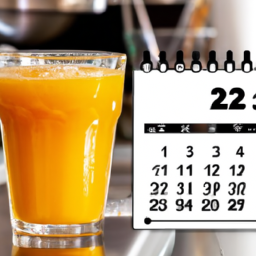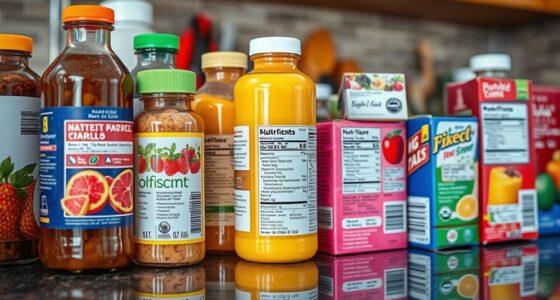I have always had a deep love for garlic. It’s not only because it enhances the taste of food, but also because of its numerous health benefits. Garlic is known for its ability to boost the immune system, lower blood pressure, and reduce the risk of heart disease. That’s why I try to incorporate garlic juice into my diet regularly.
Making garlic juice may seem like a daunting task, but it’s actually quite simple. With the right equipment and a little bit of patience, you can easily make your own garlic juice at home.
In this article, I’ll guide you through the steps of preparing garlic, choosing the right equipment, blending the garlic, and storing the juice. I’ll also share some tips for using garlic juice in cooking and drinking it for maximum health benefits.
So, let’s get started!
Key Takeaways
- Garlic juice has numerous health benefits, including boosting immunity, lowering blood pressure, and reducing the risk of heart disease.
- Making garlic juice is simple with the right equipment and safety measures, and it can be stored in glass jars with tight-fitting lids in the refrigerator or freezer for up to six months.
- Garlic juice can be used for a variety of purposes, including repelling insects and adding flavor to cooking, and it can be mixed with other herbs and spices for unique flavor profiles.
- It is important to be aware of potential risks and precautions when consuming garlic juice, such as starting with small amounts, consulting with a healthcare provider, and seeking medical attention if experiencing adverse reactions.
Health Benefits of Garlic Juice
If you’re looking for a natural way to boost your immune system and lower your risk of heart disease, then garlic juice is the way to go! Garlic is packed with antioxidants, which help to fight off harmful free radicals in the body.
These free radicals can cause damage to cells and contribute to the development of chronic diseases like cancer and heart disease. Garlic juice also contains allicin, a compound that has been shown to have antibacterial and antifungal properties, making it an effective natural remedy for skin infections and acne.
Incorporating garlic juice into your daily routine can also have benefits for your skin. Because of its antibacterial properties, it can help to reduce the appearance of blemishes and promote a clearer complexion.
To use garlic juice for skincare, simply apply a small amount to a cotton ball and gently dab onto the affected area. It’s important to note that garlic can be irritating to some skin types, so it’s best to patch test first before incorporating it into your routine.
With all these benefits, it’s no wonder that garlic juice is becoming a popular addition to many people’s daily health routines. Now, let’s move on to preparing the garlic.
Preparing the Garlic
First, you’ll need to clean the garlic thoroughly to remove any dirt or debris. Once the garlic is clean, take a few cloves and use the flat side of a knife to crush them. This will help release the juices and make it easier to peel off the skin.
To peel the garlic, simply use your fingers to remove the skin from each clove. If the skin is difficult to remove, you can also use a small knife to make a small cut and then peel it off.
Once you’ve peeled and crushed the garlic, you’re ready to move on to choosing the right equipment for making garlic juice.
Now that the garlic is properly prepared, it’s time to choose the right equipment for making garlic juice.
Choosing the Right Equipment
Now you’re ready to pick out the perfect tool for extracting the potent flavor from your garlic cloves, and you’ll be blown away by the wide variety of options available to you! When it comes to equipment options for making garlic juice, you have plenty of choices ranging from manual to electric. Some of the most common tools include garlic presses, blenders, food processors, and mortar and pestle sets. Each option comes with its own set of advantages and disadvantages, so it’s important to choose the one that works best for your needs.
When selecting your equipment, be sure to keep safety measures in mind. Some tools may require more physical effort to use, while others may have sharp blades or be more difficult to clean. Additionally, it’s important to follow the manufacturer’s instructions carefully to avoid injury or damage to the equipment. Once you have your equipment selected and ready to go, it’s time to move onto the next step of adding other ingredients to create your perfect garlic juice blend.
Adding Other Ingredients
Once you’ve got your chosen equipment, it’s time for you to start experimenting with different ingredients to create a delicious and unique flavor for your garlic blend. Garlic juice combinations can include lime juice, lemon juice, honey, ginger, apple cider vinegar, and even fruits like pineapple or orange. These ingredients can help to balance out the strong flavor of garlic and create a more complex taste.
Aside from using it as a condiment or seasoning, there are alternative uses of garlic juice. You can add it to your skincare routine as a natural remedy for acne or use it as a hair mask to promote hair growth. Garlic juice is also believed to have health benefits such as reducing inflammation and boosting the immune system.
With these possibilities, garlic juice can be a versatile addition to your kitchen and beauty arsenal. Moving on to the next section, blending the garlic will help to extract the juice and create a smooth texture.
Blending the Garlic
To achieve a smooth and consistent texture, it’s essential to blend your garlic mixture thoroughly. There are several blending techniques that you can use, depending on your preference and the equipment you have available.
If you have a high-speed blender, it’s best to start on a low speed and gradually increase to high, blending for about 1-2 minutes. This will help to ensure that the garlic is pureed evenly and there are no large chunks left.
If you don’t have a high-speed blender, you can still achieve a smooth consistency by blending for a longer time or using a food processor. You may also want to experiment with alternative garlic juice recipes, such as adding lemon juice or water to thin out the mixture.
Whatever blending technique you choose, make sure that the garlic is fully broken down before moving on to the next step of straining the garlic juice.
Straining the Garlic Juice
You’re ready to move on to the next step of this process. Here’s how to strain your garlic juice with ease:
- Use a fine-mesh strainer or cheesecloth to filter out any solid bits of garlic. A coffee filter or paper towel can also work in a pinch.
- Press the garlic pulp against the strainer or cheesecloth to extract as much juice as possible.
- For a smoother consistency, you can blend the garlic juice again after straining.
Garlic juice can be consumed in a variety of ways. If you’re not a fan of the strong garlic flavor, there are alternatives to straining. You can dilute the juice with water or mix it with other juices like lemon or ginger for a more palatable taste. Now that you’ve strained your garlic juice to perfection, it’s time to move on to the next step of storing it for future use.
Storing the Garlic Juice
Now that you have extracted the flavorful liquid, let’s talk about how to store it for future use. Storing garlic juice properly is important to maintain its freshness and prevent contamination. Ideal containers for garlic juice are glass jars with tight-fitting lids. Plastic containers are not recommended as they can absorb the garlic odor and affect its flavor.
Refrigeration or freezing are the two best methods for storing garlic juice. If you plan to use it within a week, store it in the refrigerator. However, if you want to keep it for a longer period, freezing is the best option. Garlic juice can last up to six months in the freezer. To avoid waste, reuse leftover garlic juice in other recipes such as marinades, dressings, and dips. Additionally, homemade preservatives and natural flavors such as lemon juice or vinegar can be added to garlic juice for a longer shelf life. Avoid contamination by washing your hands and equipment thoroughly before handling garlic juice. Lastly, garlic juice has practical uses outside the kitchen, such as repelling insects and pests in the garden.
Moving on to using garlic juice in cooking, it’s a versatile ingredient that adds a burst of flavor to any dish.
Using Garlic Juice in Cooking
I love adding flavor to my dishes, and one of my favorite ingredients to use is garlic juice. It not only adds a delicious flavor to my meals, but it also has health benefits.
Additionally, I often use garlic juice as a marinade for meats and vegetables. This infuses them with a rich, savory taste.
Adding Flavor to Dishes
Adding a burst of flavor to your dishes has never been easier with the addition of fresh garlic juice. Garlic juice can be used in a variety of ways to add an extra punch of flavor to your meals. Experiment with different flavor combinations by mixing garlic juice with other herbs and spices, such as thyme or ginger, to create unique and creative flavor profiles.
One creative use for garlic juice is to mix it with honey and soy sauce to make a sweet and savory glaze for meat or vegetables. Another option is to mix it with olive oil and lemon juice to make a zesty dressing for salads or roasted vegetables. The possibilities are endless when it comes to using garlic juice to add flavor to your dishes.
To continue enhancing the flavor of your dishes, try using garlic juice as a marinade. Marinating meat or vegetables in garlic juice can help tenderize and infuse them with flavor.
In the next section, I’ll discuss the steps for using garlic juice as a marinade to take your dishes to the next level.
Using Garlic Juice as a Marinade
Get ready to take your taste buds on a flavorful journey by infusing your favorite meats and veggies with a burst of flavor that’ll leave you feeling as satisfied as a cat in a sunbeam. Using garlic juice as a marinade is one of the most effective marinating techniques out there, as it not only adds a delicious taste to your dishes but also helps tenderize meats and veggies.
Here are some recipe variations to try out:
-
Classic Garlic Marinade: Mix together garlic juice, olive oil, salt, and pepper for a simple yet delicious marinade that works well with chicken, beef, fish, and vegetables.
-
Asian-inspired Garlic Marinade: Combine garlic juice, soy sauce, honey, rice vinegar, and sesame oil for a flavorful marinade that pairs well with stir-fried veggies and grilled meats.
-
Spicy Garlic Marinade: Add a kick to your dishes by mixing garlic juice, hot pepper flakes, honey, and lime juice for a fiery marinade that works well with shrimp, chicken, and tofu.
-
Italian-inspired Garlic Marinade: Mix garlic juice, balsamic vinegar, olive oil, dried oregano, and red pepper flakes for a tasty marinade that pairs well with grilled vegetables and meats.
Experiment with different marinade combinations and find what works best for your taste buds.
Now, let’s move on to some tips for drinking garlic juice.
Tips for Drinking Garlic Juice
To fully reap the benefits of garlic juice, it’s important to regularly incorporate it into your diet and find ways to make it enjoyable. Drinking garlic juice regularly can help boost your immune system, improve cardiovascular health, and even aid in digestion. However, it’s important to note that excessive consumption of garlic juice may lead to potential risks such as bad breath, body odor, and upset stomach.
When incorporating garlic juice into your diet, it’s important to consider the ideal drinking frequency. It’s recommended to drink garlic juice once a day, preferably on an empty stomach, to maximize its benefits. However, it’s important to start with small amounts and gradually increase the intake to avoid any adverse reactions. It’s also recommended to mix garlic juice with other ingredients like honey or lemon juice to make it more palatable.
It’s crucial to take precautions and be aware of the potential side effects when consuming garlic juice.
In the next section, we will discuss the precautions and side effects of using garlic juice to ensure that you drink it safely and effectively.
Precautions and Side Effects
Before consuming garlic juice, it’s important for you to be aware of the precautions and potential side effects that may occur. Garlic is generally considered safe when consumed in moderate amounts, but excessive consumption can lead to side effects such as bad breath, body odor, and heartburn. Here are some precautions and side effects to keep in mind when consuming garlic juice:
-
Avoiding allergies: Some individuals may be allergic to garlic. If you experience symptoms such as itching, swelling, or difficulty breathing, stop consuming garlic juice and seek medical attention immediately.
-
Possible interactions with medications: Garlic may interact with certain medications, such as blood thinners and HIV medications. It’s important to consult with your healthcare provider before consuming garlic juice if you are taking any medications.
-
Digestive issues: Excessive consumption of garlic juice may lead to digestive issues such as diarrhea and bloating. It’s important to consume garlic juice in moderation and to gradually increase your intake to avoid these side effects.
While garlic juice has many health benefits, it’s important to be aware of the potential side effects and to consume it in moderation. If you have any concerns about consuming garlic juice, it’s always best to consult with your healthcare provider.
Frequently Asked Questions
How long does garlic juice last once it’s been made?
I have found that garlic juice can last for up to a week when stored properly in an airtight container in the refrigerator. Other preservation methods include freezing the juice in ice cube trays or adding vinegar to increase its shelf life. It’s important to note that the potency of the juice may decrease over time.
Can I freeze garlic juice for later use?
Freezing garlic juice is a great option for later use. It extends the shelf life of the juice and preserves its flavor. I recommend freezing it in small portions for convenience. However, don’t expect it to last forever, hyperbole aside.
How much garlic juice should I consume each day for optimal health benefits?
I consume one teaspoon of garlic juice daily for its potential health benefits. Garlic juice consumption has been linked to reduced blood pressure, improved immune function, and potential cancer-fighting properties. Consult a healthcare professional for personalized advice.
Can I use garlic powder instead of fresh garlic when making garlic juice?
While garlic powder can be used to make juice, fresh garlic is recommended for optimal nutritional value. Garlic juice has higher antioxidant content than other juices and should be consumed in moderation for optimal health benefits.
Does drinking garlic juice have any negative effects on medication?
Do you take medication regularly? Garlic juice may interact negatively with certain medications. Consult with a doctor before consuming garlic juice. Dosage recommendations vary depending on the individual’s health and medication history.
Conclusion
In conclusion, making garlic juice is a simple and effective way to receive the many health benefits associated with this pungent vegetable. Whether you’re using it in cooking or drinking it straight, garlic juice is a potent ingredient that can help boost your immune system, reduce inflammation, and improve heart health.
But before you dive into making your own garlic juice, it’s important to remember a few key tips. Always choose fresh garlic, invest in a high-quality blender or juicer, and consider adding other ingredients to balance out the flavor profile.
And if you’re hesitant to drink garlic juice straight, try incorporating it into your favorite recipes for a subtle kick of flavor and added health benefits.
So, why not give garlic juice a try and see how it can improve your overall health and wellbeing? After all, as the old saying goes, "an apple a day keeps the doctor away"- but what about garlic? Can this potent vegetable be the key to unlocking a healthier, happier life? Only one way to find out – start juicing!
Ilana has been a vegan for over 10 years. She originally made the switch for health reasons, but soon found herself becoming more and more passionate about the ethical and environmental implications of a vegan lifestyle. Ilana is the author of The Graceful Kitchen, a blog all about veganism. She loves to cook up delicious and nutritious vegan meals, and share her recipes with others who are interested in leading a cruelty-free life. Ilana is also a strong advocate for using whole foods as the foundation of a healthy diet, and believes that going vegan is one of the best ways to achieve this.










